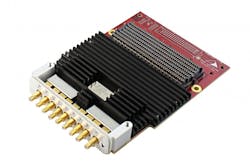Scaling FPGA Mezzanine Card (FMC) capabilities for evolving high speed data needs (Part 1)
Field Programmable Gate Array (FPGA) technology has been a game changing capability for many years. FPGAs have negated the need for ASIC technology in certain applications and have reduced the cost for custom IP algorithms in silicon. Furthermore, FPGAs have de-risked designs by allowing engineers to modify their logic after silicon is on a board.
With all those benefits, FPGAs remain somewhat specialized as compared to their CPU and GPU counterparts, as demonstrated by considerably higher FPGA device costs than these technologies - albeit less than the ASIC alternative. FPGA flexibility leads end users to demand a myriad of interfaces and configurations, and this often makes it difficult for a COTS manufacturer to make a common product for many users.
From a business standpoint, creating a custom product for every customer isn’t scalable and is counter to the notion of “off-the-shelf”. Thus, if FPGA technology was to be a viable product for a mass market, it would necessitate a modular way to offer many different configurations on a common platform - so standards were needed. VITA saw an opportunity to drive such a standard, and FMC was born with VITA 57.1.
Evolution trajectory
Moore’s Law states that semiconductor density will double every year and a half. This certainly applies to digital gate technology; however, analog conversion technology has a similar evolution trajectory, but often releases on a different cadence than digital devices. As a result, there is even more motivation for modular decoupling of these two technologies.
The goal of FMC was to make FPGA COTS viable. However, I believe it hasn’t realized that potential fully due to the complexity of devices placed on FMC products.
There are two reasons for this: technology and business. Technologically, as ADCs and DACs have evolved, they now require extremely high speed serial interfaces - pushing the limits of the FMC digital bus interface with rates exceeding 12 Gbps. This makes signal integrity of great importance, and controlling both sides of the interface is often required.
The business reasons are rooted in this technology challenge such that that COTS providers often want to sell both the FPGA board and the FMC for increased revenue as well as to simplify technical support with an improved customer experience. Since the inception of FMC, few COTS providers have sold FMC boards independent of FPGA cards - but those who have saw success in partnership with suppliers such as Xilinx. 4DSP was one such company that has remained faithful to the standard and, even though it was acquired by Abaco Systems in 2016, remains a leading supplier of FMC boards on in-house carriers as well as Xilinx evaluation platforms today.


